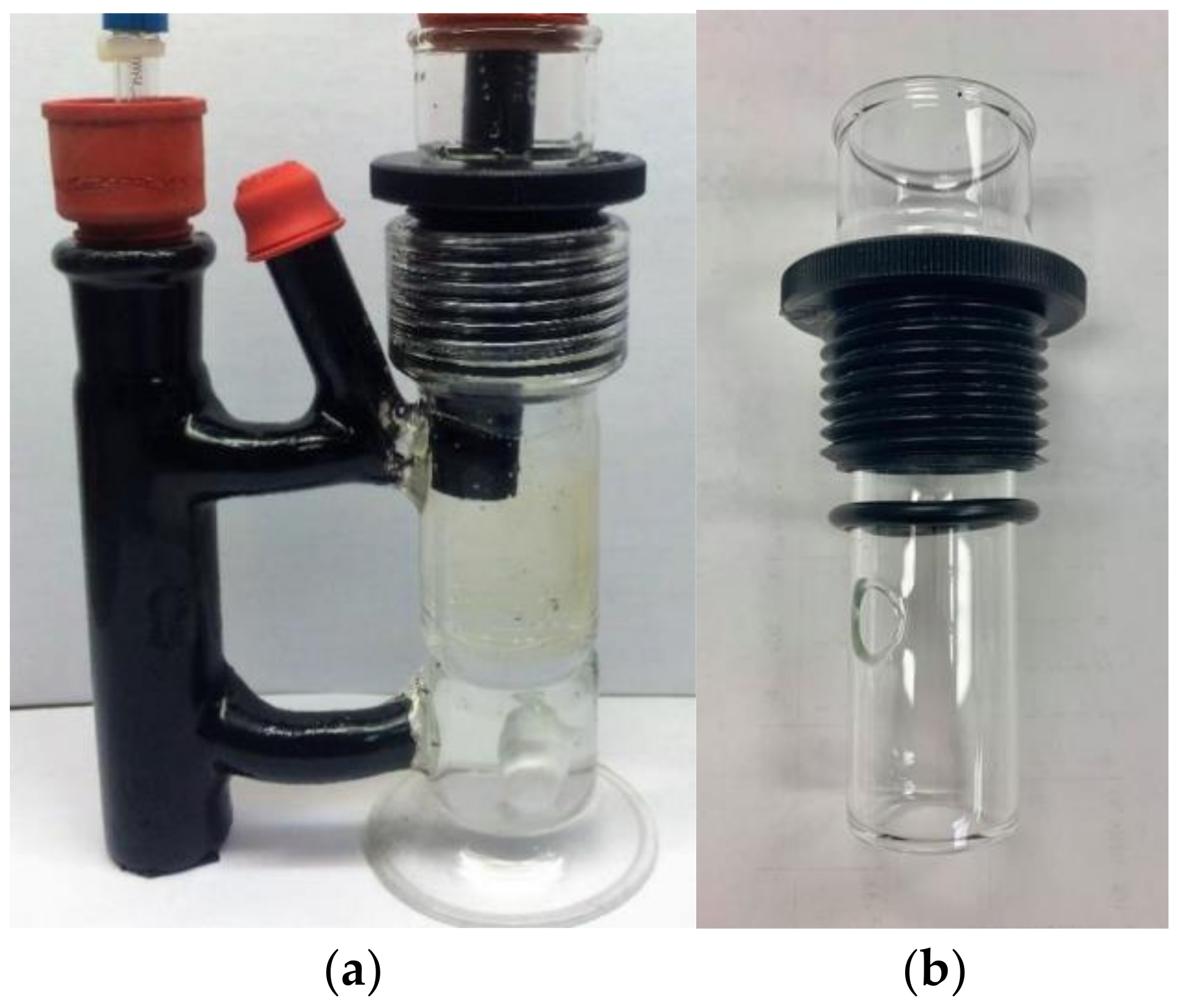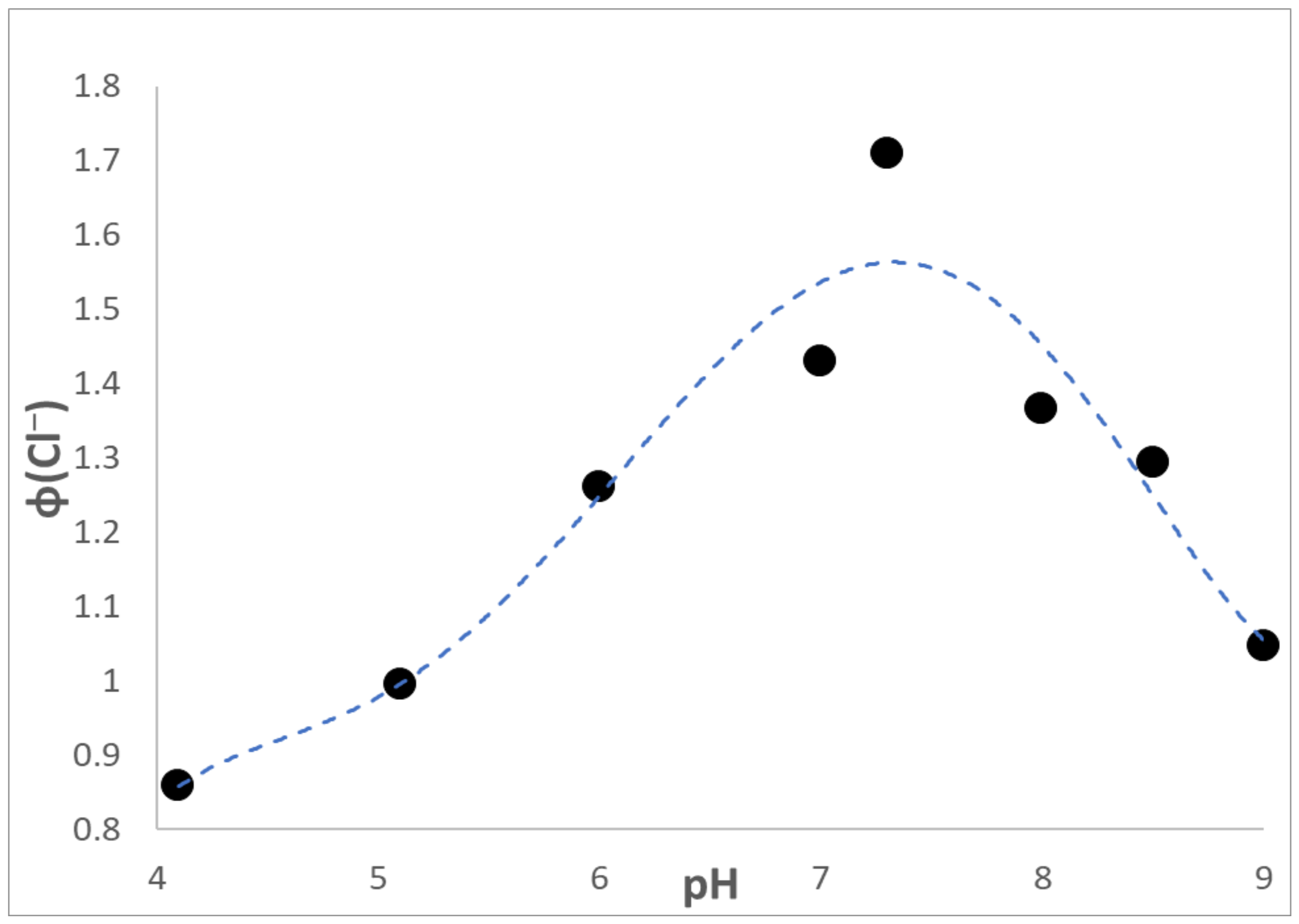Chain Reduction of CHCl3 Photocatalyzed by SPEEK/PVA Films Swollen in Air-Saturated HCO2Na Solutions
Abstract
:1. Introduction
2. Materials and Methods
2.1. Materials
2.2. Methods
3. Results
3.1. Photochemical Experiments
3.2. Additional Determinations
4. Discussion
5. Conclusions
Author Contributions
Funding
Institutional Review Board Statement
Informed Consent Statement
Data Availability Statement
Acknowledgments
Conflicts of Interest
References
- Ferguson, C.T.J.; Zhang, K.A.I. Classical Polymers as Highly Tunable and Designable Heterogeneous Photocatalysts. ACS Catal. 2021, 118, 9547–9560. [Google Scholar] [CrossRef]
- Banerjee, T.; Podjaski, F.; Kröger, J.; Biswal, B.P.; Lotsch, B.V. Polymer Photocatalysis for Solar-to-Chemical Energy Conversion. Nat. Rev. Mater. 2021, 6, 168–190. [Google Scholar] [CrossRef]
- Dai, C.; Liu, B. Conjugated Polymers for Visible Light-Driven Photocatalysis. Energy Environ. Sci. 2020, 13, 24–52. [Google Scholar] [CrossRef]
- Zhou, J.; Allonas, X.; Ibrahim, A.; Liu, X. Progress in the Development of Polymeric and Multifunctional Photoinitiators. Prog. Polym. Sci. 2019, 99, 101165. [Google Scholar] [CrossRef]
- Nowakowska, M.; Szczubialka, K. Photoactive Polymeric and Hybrid Systems for Photocatalytic Degradation of Water Pollutants. Polym. Degrad. Stab. 2017, 145, 120–141. [Google Scholar] [CrossRef]
- Yang, P.; Yang, W. Surface Chemoselective Phototransformation of C-H Bonds on Organic Polymeric Materials and Related High-Tech Applications. Chem. Rev. 2013, 113, 5547–5594. [Google Scholar] [CrossRef]
- Koizume, H.; Shiraishi, Y.; Hirai, T. Temperature-Controlled Photosensitization Properties of Benzophenone-Conjugated Thermoresponsive Copolymers. J. Phys. Chem. B 2008, 112, 13238–13244. [Google Scholar] [CrossRef]
- Bourdelande, J.L.; Font, J.; Sánchez-Ferrando, F. The Use of Insoluble Benzoylated Polystyrene Beads (Polymeric Benzophenone) in Photochemical Reactions. Can. J. Chem. 1983, 61, 1007–1016. [Google Scholar] [CrossRef]
- Gilbert, A.; Baggot, J. Essentials of Molecular Photochemistry; CRC Press: Boca Raton, FL, USA, 1991; pp. 287–353. [Google Scholar]
- Black, J.R.; Islam, M.S.; Carmichael, H.L.; Slaten, B.L.; Little, B.K.; Mills, G. Radical Chain Reduction of CCl4 Initiated by Illumination of SPEEK Solutions. J. Phys. Chem. A 2017, 121, 3918–3928. [Google Scholar] [CrossRef]
- Islam, M.S.; Duin, E.C.; Slaten, B.L.; Mills, G. Photoreduction of CHCl3 in Aqueous SPEEK/HCO2- Solutions Involving Free Radicals. J. Phys. Chem. A 2018, 122, 7118–7130. [Google Scholar] [CrossRef]
- Islam, M.S.; Dissanayaka, R.; Higgins, B.T.; Adhikari, S.; Mills, G. Photoreduction of CCl3F in Aqueous Solutions Containing Sulfonated Poly(ether etherketone) and Formate Buffers. Res. Chem. Intermed. 2019, 45, 4015–4028. [Google Scholar] [CrossRef]
- Kueper, B.H.; Stroo, H.F.; Vogel, C.M.; Ward, C.H. Source Zone Remediation: The State of the Practice. In Chlorinated Solvent Source Remediation; Kueper, B.H., Stroo, H.F., Vogel, C.M., Ward, C.H., Eds.; Springer: New York, NY, USA, 2014; pp. 1–27. [Google Scholar] [CrossRef]
- Rubin, H. POLLUTION/Groundwater. In Encyclopedia of Soils in the Environment, 1st ed.; Hillel, D., Ed.; Elsevier: Oxford, UK, 2005; Volume 3, pp. 271–281. [Google Scholar]
- Henderson, M.A. A Surface Science Perspective on TiO2 Photocatalysis. Surface Sci. Rep. 2011, 66, 185–297. [Google Scholar] [CrossRef]
- Hsiung, T.-L.; Wei, L.-W.; Huang, H.-L.; Wang, H.P. In situ X-ray Absorption Spectroscopy Studies of TiO2 Photocatalytic Active Sites for Degradation of Trace CHCl3 in Drinking Water. J. Synchrotron Rad. 2021, 28, 1839–1844. [Google Scholar] [CrossRef]
- Lockhart, P.; Little, B.K.; Slaten, B.L.; Mills, G. Photogeneration of H2O2 in Water-Swollen SPEEK/PVA Polymer Films. J. Phys. Chem. A 2016, 120, 3866–3877. [Google Scholar] [CrossRef] [PubMed]
- Henson, J.H.L.; Hybart, F.J. The Degradation of Poly(vinyl Chloride). I. Hydrogen Chloride Evolved from Solid Samples and from Solutions. J. Appl. Polym. Sci. 1972, 16, 1653–1662. [Google Scholar] [CrossRef]
- Horvath, A.L. Halogenated Hydrocarbons: Solubility-Miscibility with Water; Marcel Dekker: New York, NY, USA, 1982; pp. 484–485. [Google Scholar] [CrossRef]
- Heller, H.G.; Langan, J.R. Photochromic heterocyclic fulgides. Part 3. The use of (E)-α-(2,5-dimethyl-3-furylethylidene)(isopropylidene)succinic anhydride as a simple convenient chemical actinometer. J. Chem. Soc. Perkin Trans. 2 1981, 341–343. [Google Scholar] [CrossRef]
- Griffith, D.W.T.; Deutscher, M.N.; Caldow, C.G.R.; Kettlewell, G.; Riggenbach, M.; Hammer, S. A Fourier Transform Trace Gas Analyzer for Atmospheric Applications. Atmos. Meas. Tech. Discuss. 2012, 5, 3717–3769. [Google Scholar] [CrossRef]
- Huyser, E.S. Free-Radical Chain Reactions; Wiley-Interscience: New York, NY, USA, 1970; pp. 31–52. [Google Scholar]
- Ledger, M.B.; Porter, G. Primary Photochemical Processes in Aromatic Molecules. Part 15.—The Photochemistry of Aromatic Carbonyl Compounds in Aqueous Solution. J. Chem. Soc. Faraday Trans. 1 1972, 68, 539–553. [Google Scholar] [CrossRef]
- Ulanski, P.; Bothe, K.; Rosiak, J.M.; von Sonntag, C. OH-Induced Crosslinking and Strand Breaking of Poly(vinyl alcohol) in Aqueous Solution in the Absence and Presence of Oxygen. A Pulse Radiolysis and Product Study. Macromol. Chem. Phys. 1994, 195, 1443–1461. [Google Scholar] [CrossRef]
- Ulanski, P.; Bothe, E.; Hildenbrand, K.; Rosiak, J.M.; von Sonntag, C. Hydroxyl-Radical-Induced Reactions of Poly(Acrylic Acid); a Pulse Radiolysis, EPR and Product Study. Part I. Deoxygenated Aqueous Solutions. J. Chem. Soc. Perkin Trans. 2 1996, 13–22. [Google Scholar] [CrossRef]
- Tromans, D. Temperature and Pressure Dependent Solubility of Oxygen in Water: A Thermodynamic Analysis. Hydrometallurgy 1998, 48, 327–342. [Google Scholar] [CrossRef]
- Neta, P.; Grodkowski, J.; Ross, A.B. Rate Constants for Reactions of Aliphatic Carbon-Centered Radicals in Aqueous Solution. J. Phys. Chem. Ref. Data 1996, 25, 709–1050. [Google Scholar] [CrossRef]
- Ramseier, M.; Senn, P.; Wirz, J. Photohydration Benzophenone in Aqueous Acid. J. Phys. Chem. A 2003, 107, 3305–3315. [Google Scholar] [CrossRef]
- Shizuka, H.; Obuchi, H. Anion-Induced Triplet Quenching of Aromatic Ketones by Nanosecond Laser Photolysis. J. Phys. Chem. 1982, 86, 1297–1302. [Google Scholar] [CrossRef]
- Kitto, D.; Kamcev, J. Mannig Condensation in Ion Exchange Membranes: A Review on Ion Partitioning and Diffusion Models. J. Polym. Sci. 2022, 60, 2929–2973. [Google Scholar] [CrossRef]
- Liu, S.; Ghosh, K.; Muthukumar, M. Polyelectrolyte Solutions with Added Salt: A Simulation Study. J. Chem. Phys. 2003, 119, 1813–1823. [Google Scholar] [CrossRef]






Disclaimer/Publisher’s Note: The statements, opinions and data contained in all publications are solely those of the individual author(s) and contributor(s) and not of MDPI and/or the editor(s). MDPI and/or the editor(s) disclaim responsibility for any injury to people or property resulting from any ideas, methods, instructions or products referred to in the content. |
© 2023 by the authors. Licensee MDPI, Basel, Switzerland. This article is an open access article distributed under the terms and conditions of the Creative Commons Attribution (CC BY) license (https://creativecommons.org/licenses/by/4.0/).
Share and Cite
Dissanayaka, R.; Islam, M.S.; Mills, G. Chain Reduction of CHCl3 Photocatalyzed by SPEEK/PVA Films Swollen in Air-Saturated HCO2Na Solutions. Materials 2023, 16, 6629. https://doi.org/10.3390/ma16206629
Dissanayaka R, Islam MS, Mills G. Chain Reduction of CHCl3 Photocatalyzed by SPEEK/PVA Films Swollen in Air-Saturated HCO2Na Solutions. Materials. 2023; 16(20):6629. https://doi.org/10.3390/ma16206629
Chicago/Turabian StyleDissanayaka, Radini, Md Safiqul Islam, and G. Mills. 2023. "Chain Reduction of CHCl3 Photocatalyzed by SPEEK/PVA Films Swollen in Air-Saturated HCO2Na Solutions" Materials 16, no. 20: 6629. https://doi.org/10.3390/ma16206629
APA StyleDissanayaka, R., Islam, M. S., & Mills, G. (2023). Chain Reduction of CHCl3 Photocatalyzed by SPEEK/PVA Films Swollen in Air-Saturated HCO2Na Solutions. Materials, 16(20), 6629. https://doi.org/10.3390/ma16206629





